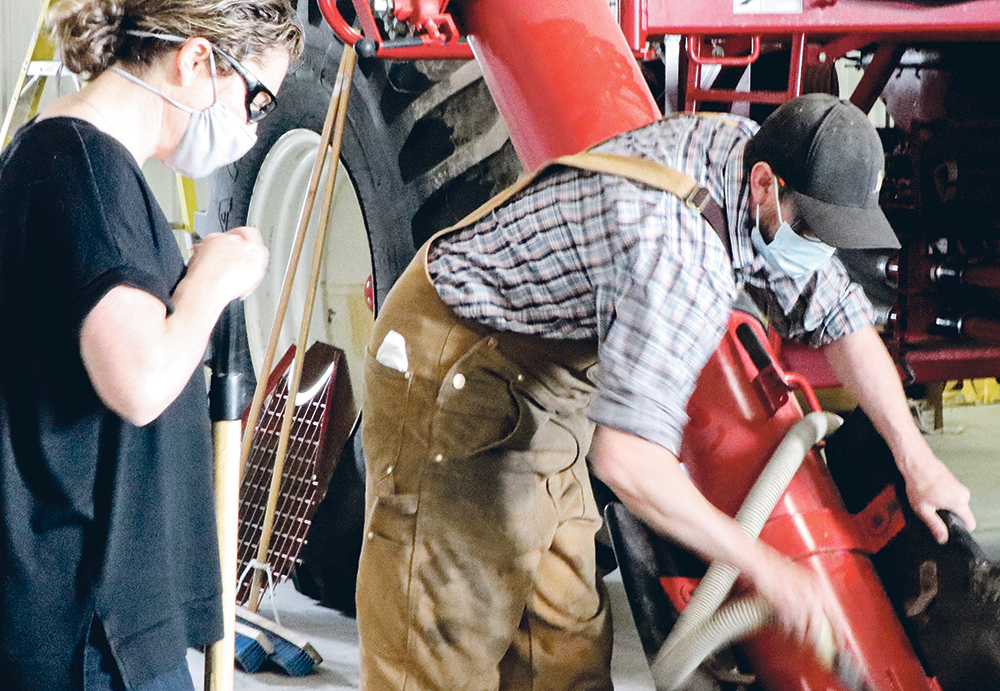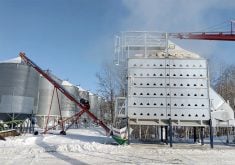Equipment purchases today may have consequences years down the road, especially if electronic reliability, maintenance and right to repair escalate into valid reasons to keep older implements on the farm.
Everyone has heard horror stories of combines sitting still for days during harvest and sprayers that break down at the peak of spraying season. The glitches don’t show up until it’s time for the machine to get out in the field and work. And a system that works according to specification in the yard may fail after one round in the field, as a Manitoba farmer learned.
Read Also

Organic farmers urged to make better use of trade deals
Organic growers should be singing CUSMA’s praises, according to the Canadian Chamber of Commerce.
On April 30, 2019, I met with Andy Scheurer in the Dugald area east of Winnipeg, to learn about the new $450,000 Horsch Maestro machine he and his brother had just purchased.
When everything works as intended, precise seed spacing is managed by an electric motor meter on each row unit. The digitally controlled motors provide individual row unit control. They respond instantly to commands, providing unprecedented control over seed placement within the row.
That’s when everything works as intended.
It was Scheurer’s first day in the field with the still-shiny Maestro. He had made one round of a canola field he was custom seeding for a neighbour. That’s when the electronics brought the whole rig to a sudden screeching halt.
Scheurer had been sitting in the field for more than four hours when I got there. There were no manual overrides on the systems. The only available technician was a four-hour drive away, and he was tied up. Scheurer was angry.
About 100 kilometres north of Scheurers, near East Selkirk, Man., another producer offered his opinion on the issue of electronic reliability.
“If brand new equipment behaves like that now, what’s it going to be like when it’s five years old? It’s hard to imagine new half-million-dollar machines getting better as they age,” said East Selkirk farmer Brian Yokimas.
He admits he’s an “old fart,” which tempers his opinion, although he does have autosteer on all his equipment. However, he is shy about admitting he’s one of the best implement rebuilders on the Prairies, so that also tempers his opinion. Why scrap a machine if you can bring it back to near-new condition?
“Look at the prices right now for good used tractors and combines. Farmers are becoming more reluctant to pay for new equipment only to have it sit still in the field. That has a lot to do with demand for older machines,” says Yokimas.
“Everyone accepts autosteer, but that’s as far as most people want to go. No further. The puzzling part is all the extra electronics are not necessary. I used to have old 980 New Holland combines and they would make seed grade samples. So, you can’t say that because it’s a newer combine, it’s a better combine. The electronics are not necessary.”
Yokimas, who farms 1,600 acres with his son, says a person might think about long-term reliability if they’re analyzing implement needs for the future and they plan to keep the farm in the family.
Leah Olson, chief executive officer with the Prairie Agricultural Machinery Institute, echoes the thought many farmers express about new technologies.
“There’s no doubt it’s pretty scary when you depend on a new technology and it fails. Because you’re totally tied to it. The frustration is extreme when you’re stopped in the field looking at a screen that just has that circle going around and around,” said Olson.
“It’s vital to surround yourself with a strong network of knowledgeable people who can help you learn to operate the systems and extract the best performance. Make sure the dealership can support you with information and technicians. When systems don’t operate as they should, I know the manufacturers are anxious to hear about it, mainly through the dealers.
“If I was faced with an implement buying decision, my first consideration would always be my return on investment. I need a cost/benefit analysis. If that doesn’t pencil out, then my decision is made for me.
“But if the purchase does pencil out, then I need to know who in my network can help me work through the operating systems. That’s critical.”
Olson says the farm labour shortage has been a huge stimulus to electronic controls, especially in the area of automation. In the 1980s and ‘90s, farmers were welders, machinists, inventors and fabricators. That allowed zero till to evolve and mature and allowed prairie manufacturers to become world leaders in seeding equipment.
“When it comes to electronics, I’ve seen leaps and bounds by farmers young and old working on electronic equipment in their farm machines. At the other end, I know farmers who still don’t have autosteer. They just don’t trust it. They’re nervous about it,” says Olson.
“I’m not nervous about it. If it was my decision, I would buy if the ROI was right. But then, I’m more than an early adopter. I’ve been working with machinery my whole adult life. I believe the future of agricultural production is electronic and autonomous.
“There’s no doubt it’s fun to be on the sprayer or the combine or the seeding tractor. You definitely like to look at the land and see how things are growing. At the same time, we should be looking at how to ease the stress on the operator. I feel it’s our duty to do that.”
The Western Equipment Dealers Association says the lack of high-speed rural broadband is the biggest factor contributing to farmers distrust of the latest technology, said WEDA vice-president Larry Hertz.
“The reliability of electronic equipment has greatly improved, but farmers need broadband to get optimal performance out of their new equipment,” said Hertz, adding that the technology is designed to be connected to the cloud.
“Working in an area with no high speed robs your equipment of its full potential. You’re not in a position to utilize machine learning and artificial intelligence.
“If you have a combine that’s engineered to be connected to the clouds through a portal, you get no benefit if you can’t connect to that portal. If you have an error code, you can’t use the technology to diagnose it in the field unless you can access the portal. Without high speed broadband you’re on the outside looking in.”
Hertz says equipment being manufactured now is fully equipped for connectivity, machine learning and artificial intelligence. Lack of broadband is not the manufacturers’ fault. It’s the fault of government and service providers.
WEDA recently met with provincial ag ministers to explain why farmers need a robust broadband.
“One of my brothers farms a half hour drive from Regina,” says Hertz. “Before he heads to the field in the morning, he has to download his field map at his computer in the house, put it on a thumb drive, take the thumb drive out to the equipment and plug it in and download the map. Now he’s ready to work.
“But every time he gets behind some bush or the other side of a hill, he loses the signal. The whole idea behind mapping software is that it’s supposed to be live real time.
“A couple years ago we had the president of Microsoft Canada at our annual WEDA conference. He was talking about the availability of TV white space. Everybody’s on digital now so the UHS and VHS channels are available. Microsoft was trying to integrate TV white space with cellular towers, Wi-Fi hotspots, mobile hotspots and other channels.
“There’s amazing technology on modern implements. It can increase a farmer’s productivity immensely, but you can’t use it without highspeed broadband. If you’re concerned about equipment and the long term future of your family farm, maybe the smartest thing you can do right now is get political and put some pressure on the federal government. It’s a federal responsibility.”
Hertz points out that a farmer with a 10-year-old combine who wants to upgrade by five years will automatically move into a more complex unit. When thinking about the future of the farm, the equipment purchased in the future will have more software and sensors.
“It’s interesting to note that only five percent of ag equipment breakdowns are related to electronic systems. Ninety-five percent of the breakdowns were mechanical.”
One implement broker, who asked not to be named to protect his business ties, elaborated further.
“I work with dealers, so I know what it’s all about. Farmers do get stuck when the electronics fail and its usually sensors. There are so many sensors now with all the things they monitor,” he says.
When the engine goes into limp mode, the only cure is to call the technician with the test equipment. That wastes time regardless of season. A farmer may want to diagnose the problem and repair it themselves, but if warranty is involved, it can evaporate when the dealer finds out.
“Farmers don’t have the certification to touch anything if the tractor is still on warranty. It can only be repaired by a certified technician. That factor alone would prevent some farmers from buying a new implement,” the broker says.
“A lot of farmers have big heated shops and they have staff they want to keep all winter, so it’s logical to want to bring the pieces in one by one and do all the servicing and repair. The farmer has to make a decision. Does he want to remain tied to the dealer or does he break free and void the warranty?
“If the farmer does carry out some work himself, it leaves a fingerprint in the computer memory. So next time he needs the dealer to do some tuning or tweaking, the dealer knows it.”
The broker says liability is a major factor that discourages new equipment purchases. The grower does not have the right to sue the dealer or the manufacturer for lost income caused by a faulty implement.
In one notable case, a combine sat in the field for three days as technicians tried to solve a problem. Just as the sensor problem was solved, the rain started. It was a costly delay but with no legal recourse.
Some farmers say manufacturers and dealers are not held accountable so there is no incentive for them to improve customer service. It can seem that the idea of a customer always being right doesn’t apply to farm equipment.
As the equipment broker recalls, “a friend was combining when a chopper belt flew off and knocked away the sensor for the chopper. They scoured that field for a whole day looking for it. The machine would not run without that sensor, so they lost a whole day of combining. There’s a lot of money being lost in Western Canada every year because of electronic breakdowns.
“There’s definitely a good market for decent used machinery. I don’t know if that’s all because of electronic problems, but that is certainly a big part of it.
“Of course, the other factor driving prices on used machines is the supply chain. Even if they want to buy new, the implements simply are not available. Manufacturers have warned us that they won’t have all the components they need to meet the demand. Of course, that sends a signal to the market that drives prices up on good used equipment.”
There is general agreement that old equipment won’t function forever. When metal fatigue rears its ugly head, there’s no choice but to buy something newer. That puts farmers in the digital world, like it or not.
Says one farmer, “just accept that eventually you will buy electronically controlled equipment and these devices will fail. Build that failure and those lost days into your plan.”
















